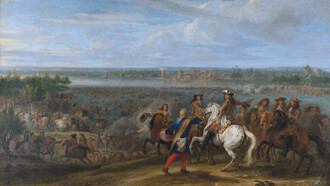Comprising extensive wetlands and renowned ancient archaeological sites, the marshlands of southern Iraq (al-Ahwar) offer some of the most remarkable cultural and natural landscapes in the world. The Huwaizah, Hammar, and Central Marshes are sustained by the Tigris and Euphrates rivers, which wind and twist south into Syria and Iraq from Turkey. Fed by the rivers, the marshlands constitute a unique freshwater system and one of the largest inland delta plains in the world, refuge for dozens of species of migratory birds and indigenous fauna. Due to the fertile land, ease of waterborne transportation, and natural biodiversity, the region was also home to some of the first cities and civilisations in the world, which left their marks in the form of sprawling archaeological sites at Ur, Uruk, and Eridu. The designation of al-Ahwar as a UNESCO World Heritage Site reflects the outstanding value it holds in the cultural record and attests to the continuity of human occupation in what has been suggested as the original site of biblical Eden.
70 years ago this month, in September 1954, an article was published in The Geographical Journal titled “The Marshmen of Southern Iraq,” written by the British military officer, traveller, and author Wilfred Thesiger. The article detailed the environment of Iraq’s southern marshes, al-Ahwar, beginning with a brief introduction to the physical characteristics of the wetlands, which “cover nearly 6,000 square miles" (Thesiger 1954: 272-273). Thesiger reported that he conducted over a year of fieldwork in the marshes, gradually gaining the confidence of the region’s inhabitants (Marsh Arabs, ‘Arab al-Ahwār), and found them to be both “welcoming and friendly.” Still, his article exhibits a degree of detached scholarly Orientalism that was not unusual for western ethnographers in the mid-20th century. He noted, for instance, that the Marsh Arabs “have a well-established reputation as thieves,” but conceded that they “have not, as yet, stolen anything from me” (Thesiger 1954: 273).
The so-called “marshmen” construct many of their homes in clusters on small islands, which Thesiger suggests are mounds indicating the locations of ancient settlements. These islands, known as ishan, were reported to be the sites of buried treasure. A quasi-mythological island called Hufaidh was said to be located in the heart of the marshes, northeast of present-day Chibayish, and the site of hidden riches, gardens laden with fruit, and djinn who turned the island invisible to protect its wealth (Thesiger 1954).
Thesiger’s account of life in al-Ahwar was an early attempt at an anthropological study of the region’s inhabitants, later refined in his 1964 book The Marsh Arabs. He just missed out on being the first sweeping ethnographic account of Marsh Arab life, however, which was Marsh Dwellers of the Euphrates Delta, published in Arabic in 1956-1957 and in English in 1962 by Iraqi anthropologist Shakir Mustafa Salim. Salim’s work resulted from fieldwork conducted in the Chibayish marshes as part of his doctoral research. In his book, he provided a history of the marshes themselves, outlining how they were believed to have been formed by the destruction of canals in south-central Iraq around the 13th century. He also describes how Ottoman forces were unable to maintain their authority in the marshlands and, despite a few incursions, power remained entirely with the local tribes.
Strangely enough, I didn’t discover Thesiger’s 1954 article because of my interest in archived issues of The Geographical Journal. Rather, I found it tucked inside a folder of intelligence provided to British Petroleum (BP) when I was researching documents in the BP Archive in 2021. Why was this journal article in the BP Archive? Who felt that it was important for BP policymakers to have this intimate knowledge of the Iraqi wetlands and their inhabitants?
In the 1950s, when the article was first published, oil production in Iraq was largely undeveloped. Extensive geological surveys of the country had revealed equally extensive reserves of oil and gas, primarily around Kirkuk in the north and Basra to the south. However, Mitchell (2011) shows how BP intentionally slowed development of oil fields, particularly in Iraq, in order to limit global supply and keep prices high. He reports how BP “deliberately drilled shallow wells to avoid discovering additional supplies and plugged wildcat wells that yielded large finds to conceal their existence from the government." Iraq holds one of the largest oil reserves in the world, but “its production in the 1950s and 1960s was kept at about half of the level” of other producers (Mitchell 2011: 147).
In 1953, the year before publication of Thesiger’s article, the South Rumailah oil field in the Al Hammar Marsh went into production. The South Rumailah field is classified as a “super-giant," which means it contains at least 5 billion barrels of recoverable crude oil. The following year (the year Thesiger’s article was published), it was discovered that the oil field extended further north into the marshlands, in what was termed the North Rumailah field. Eventually, approximately 500 square kilometres of marshlands were drained to accommodate the production of the Rumailah fields (north and south), though the northern field did not go online until 1972. This represented a first blow to the marshlands, the largest wetlands in the Middle East. Other oil reserves in the region were found in the Zubayr field (in the southeast of Al Hammar Marsh, in production since 1949), the Majnoon field (another super-giant, located in the Huweizah Marsh and first discovered in 1977), and West Qurnah (yet another super-giant, located in the Hammar and Qurnah Marshes and first developed in the late 1980s) (Al-Ansari and Knutsson 2011: 21).
Hundreds of square kilometres of marshland were drained to enable exploitation of oil resources, though this was an intentionally prolonged process. Other campaigns led to more drastic environmental changes. The first was in the 1980s, when the Iraqi government under Saddam Hussein drained large swathes of the marshes to enable the movement of troops during the Iran-Iraq War. Another consequence of the war was the severe and widespread contamination of the waterways by poison gas and munitions, which limited the ability of inhabitants to return once the conflict had subsided. From 1985 to 1992, in fact, 63% of the marshes dried up, with the al Hammar and Qurnah marshes almost entirely gone (Al-Ansari and Knutsson 2011: 21-22; Brasington 2001; Sluglett 2003a).
Another factor that contributed to the desiccation of the wetlands was the Turkish construction of dozens of dams and hydroelectric stations on the Euphrates and Tigris rivers in the 1980s and 1990s, limiting the flow of freshwater into Iraq in order to divert water for irrigation and hydroelectricity in southeast Turkey. The largest of these, Atatürk Dam, is the sixth-largest embankment dam in the world and located on the Euphrates. The irrigation and other water needs of north and central Iraq have demanded a greater percentage of the remaining water as a result, leaving less to fill the southern marshes.
Following the 1991 Gulf War, American forces encouraged Arabs in the south and Kurds in the north to revolt against and overthrow Saddam Hussein’s regime. The revolts were unsuccessful and led to a greater government crackdown on Kurds and Marsh Arabs. In the south, this resulted in the draining of nearly all the remaining marshlands and the poisoning of water supplies. Thousands migrated across the border to Iran to escape persecution. Iraqi government forces launched ground attacks against those who remained, burning villages, taking hostages, and confiscating land (Benvenisti 2003; Gleick 1993; Sluglett 2003b). The result was a massive decline in the marshes and their inhabitants, further devastating the region’s natural and cultural heritage resources.
Following the fall of Saddam Hussein’s regime in 2003, local communities demolished the structures that had been built to divert and drain the marshes, resulting in the partial restoration of the wetlands. This represents one of the most significant environmental and cultural resurgences in modern history. Large numbers of migratory birds began to return to the region along with the indigenous population. The restoration campaign, spearheaded by local communities and international organizations, reintroduced water to the drought-ridden land and led to the revival of native flora and fauna. The project was not without challenges, of course, as it faced ongoing political instability, persistent water scarcity, and the continued impact of upstream damming and water diversion projects in Turkey. Despite these obstacles, the revival efforts saw significant ecological successes, with substantial portions of the marshland re-flooded. The resurgence of the marshes also brought about a cultural renewal for Marsh Arabs as traditional lifestyles and livelihoods tied to the wetlands began to re-emerge. In 2013, the Mesopotamian Marshes were designated Iraq’s first national park. The international recognition of al-Ahwar, including its designation as a UNESCO World Heritage site in 2016, reinforced the global importance of this unique ecosystem and the success of preservation efforts.
The 70 years since the publication of Thesiger’s article have seen several periods of exploitation and devastation of al-Ahwar for reasons of resource and population management. Ongoing restoration efforts have made momentous strides in restoring the wetlands and its biological and cultural diversity. Looking forward, the region’s status as a protected World Heritage Site will hopefully safeguard it against future exploitation. As climate change represents an increasingly dire threat, these campaigns will continually need to implement new techniques for preserving the wetlands and ensuring their ecological and cultural sustainability.
References
Al-Ansari, N. and Knutsson, S. (2011). “Possibilities of Restoring the Iraqi Marshes known as the Garden of Eden.” Water and Climate Change in the MENA Region: Adaptation, Mitigation, and Best Practices. Berlin: International Conference.
Benvenisti, E. (2003). “Water Conflicts during the Occupation of Iraq.” The American Journal of International Law, 97(4): 860-872.
Brasington, J. (2001). “Monitoring Marshland Degradation Using Multispectral Remote Sensed Imagery.” In P. Clark and S. Magee (ed.s) The Iraqi Marshlands: A Human and Environmental Study. London: Politico’s Publising.
Gleick, P. H. (1993). “Water and Conflict: Fresh Water Resources and International Security.” International Security, 18(1): 79-112.
Mitchell, T. (2011). Carbon Democracy: Political Power in the Age of Oil. London: Verso.
Salim, S. M. (1962). Marsh Dwellers of the Euphrates Delta. London: Althone Press.
Sluglett, P. (2003a). “The International Context of Iraq from 1980 to the Present.” In E. Nicholson and P. Clark (ed.s) The Iraqi Marshlands: A Human and Environmental Study. London: Politico's Publishing.
Sluglett, P. (2003b). “The Marsh Dwellers in the History of Modern Iraq.” In E. Nicholson and P. Clark (ed.s) - The Iraqi Marshlands: A Human and Environmental Study. London: Politico's Publishing.
UNESCO. (2024). “The Ahwar of Southern Iraq: Refuge of Biodiversity and the Relict Landscape of the Mesopotamian Cities.” World Heritage Convention.















